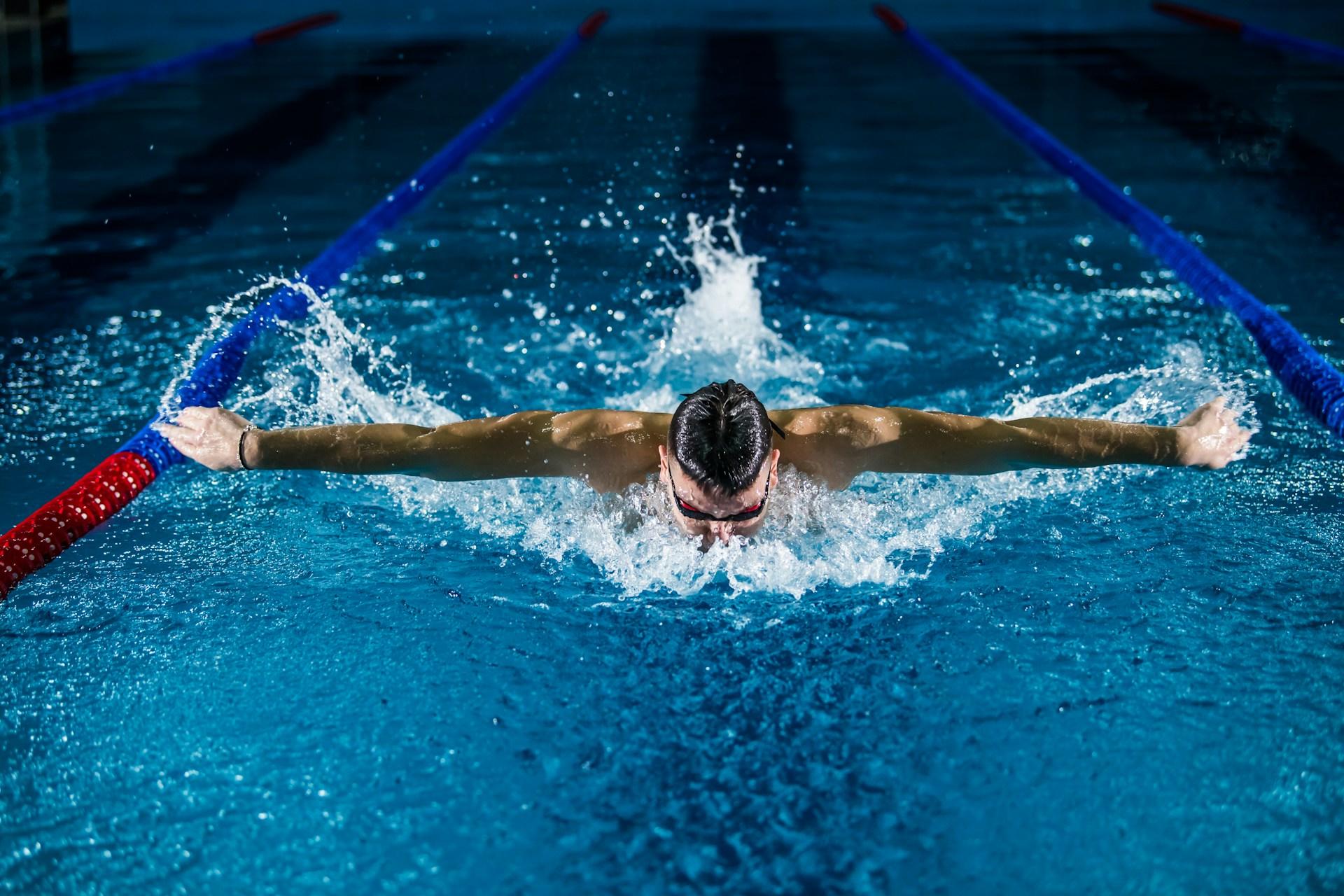The butterfly stroke is the most difficult of all of the different forms of mainstream swimming strokes. This may sound like something that is subjective, but the vast majority of people will tell you that butterfly stroke swimming is incredibly tough.
While you may opt for one of the other swimming strokes as a beginner, there are plenty of options to learn how to do butterfly stroke, too. There’s no downside to not “throwing yourself in at the deep end” (pun intended) and learning the toughest of the swimming strokes to start with.
In this guide, we’ll look at the butterfly swim stroke, the techniques used, and some top tips for those who want to utterly master this method of swimming or even use it in competitions.

How to Do Butterfly Stroke
The butterfly stroke technique may be tough, but if you are looking for a challenge or already have some of the swimming basics down, you may move onto the butterfly swim stroke. The steps below break the butterfly stroke down into easy steps. Remember, practice and hard work are essential if you’re going to become proficient.
These steps will help to get to grips with the butterfly stroke for beginners:
- Master the body position: Start by lying face down in the water with your body stretched out horizontally. Keep your body as flat as possible, with your head in line with your spine and eyes looking straight down.
- Arm movements: Begin the stroke by extending both arms forward simultaneously. Pull your arms downward and outward in a circular motion, creating a sweeping movement that should be smooth.
- Follow the motion: As your arms get to shoulder width, bend your elbows and sweep them out to the sides, keeping your hands close to the surface of the water. Continue the circular motion until your hands meet at your hips. Once your hands reach your hips, lift them out of the water and bring them back to the starting position, ready for the next stroke.
- Perfect the leg kick: You need to use a butterfly kick or a dolphin kick technique. The dolphin kick is a powerful undulating movement where both legs move in unison, resembling the motion of a dolphin's tail. Keep your legs together and your feet pointed, with the majority of the power coming from your hips and thighs. Coordinate your leg movements with your arm strokes, ensuring a fluid and continuous motion.
- Mastering your breathing: Timing is crucial when it comes to breathing in the butterfly stroke as you will not have a lot of time to breathe in. Take a breath as your arms exit the water during the recovery phase of the stroke, tilt your head to the side to inhale quickly and efficiently, then return your face to the water as your arms enter for the next stroke.
We’ve already explained how tough this can be. Mastering the coordination of arm and leg movements is key to swimming the butterfly stroke effectively and that can take many hours of practice. Focus on maintaining a steady rhythm and synchronizing your arm pulls with your leg kicks.
You can also use butterfly drills to improve your coordination, such as butterfly kick with a kickboard or single-arm butterfly drills.
Butterfly Swimming Technique
The butterfly swimming technique is an interesting one to read up about. It didn’t become mainstream until well into the 1900s. From the butterfly kick to the breathing techniques required, it can actually be one of the quickest ways of swimming compared to breaststroke or other methods.

It has more in common with breaststroke than the other forms of swimming, and is quite different from front crawl and backstroke as you would expect.
One of the earliest known practitioners of the butterfly stroke was David Armbruster, a coach from the United States. In the 1930s, Armbruster had developed a unique swimming technique known as the "butterfly breaststroke," which involved simultaneous arm movements and a dolphin kick (something he had been intrigued by since a demonstration in 1911).
This innovative approach laid the groundwork for the modern butterfly stroke and revolutionized competitive swimming. Armbruster was a 1966 International Swimming Hall of Fame Honor Coach, and coached in universities for over 30 years.
The butterfly stroke gained recognition on the international stage during the 1950s and 1960s, with swimmers like Ada Kok of the Netherlands and Geoff Vandenberg of Australia showcasing its effectiveness in competition. The FINA or "Fédération Internationale de Natation", the governing body of international swimming, had to adapt their rules regularly as they hadn’t fully accepted the use in the 1940s, and there were two main variations people used for the recovery.

It wasn't until the 1956 Olympics in Melbourne that the butterfly stroke was officially introduced as a separate event, replacing the breaststroke as the fourth stroke in competitive swimming. Michael Phelps broke the record for the fastest time when he completed 100 meters in under 50 seconds, something that has since been beat by Caeleb Dressel in men's swimming events at the Olympics.
Butterfly Stroke Rules
In competitive swimming, there are close rules that govern how to swim butterfly and how to stroke properly in a way that doesn’t provide an unfair advantage. The current rules from the FINA explain:
SW 8.1 From the beginning of the first arm stroke after the start and each turn, the body shall be kept on the breast. It is not permitted to roll onto the back at any time, except at the turn after the touch of the wall where it is permissible to turn in any manner as long as the body is on the breast when leaving the wall.
SW 8.2 Both arms shall be brought forward simultaneously over the water and brought backward simultaneously under the water throughout the race, subject to SW 8.5.
SW 8.3 All up and down movements of the legs must be simultaneous. The legs or the feet need not be on the same level, but they shall not alternate in relation to each other. A breaststroke kicking movement is not permitted.
SW 8.4 At each turn and at the finish of the race, the touch shall be made with both hands separated and simultaneously, at, above or below the water surface.
SW 8.5 At the start and at turns, a swimmer is permitted one or more leg kicks and one arm pull under the water, which must bring him to the surface. It shall be permissible for a swimmer to be completely submerged for a distance of not more than 15 metres after the start and after each turn. By that point, the head must have broken the surface. The swimmer must remain on the surface until the next turn or finish.
How to Master the Butterfly Stroke: Advanced Tips
Let’s explore the top tips for butterfly swim techniques, and how you can become an absolute master. If you are looking to do the butterfly stroke in a professional meet, you’ll need to go through a lot of butterfly drills and enhance your ability levels to be able to compete at a high level.

Focus on Timing
Timing is key to the momentum in the butterfly stroke. Achieve the best timing between your arm pulls and leg kicks to maximize propulsion and efficiency. Coordinate your movements seamlessly, ensuring that your arms and legs work together in a continuous and rhythmic motion, and if you get the chance, record yourself swimming. This is a chance to scrutinize and work on your technique.
Build Your Power
Perfect the dolphin kick as the primary source of propulsion in the butterfly stroke, and work on your power to make sure you kick through with a lot of momentum. Working on your power is important if you want to be fast and competitive.

Generate power from your hips and thighs, executing a strong and rhythmic motion with your legs. Practice drills to improve the strength and flexibility of your kick, some of these don’t even require you to be in the water, and of course, there are things you can do in the gym to benefit your strength.
Improve the Turn
This is something that is crucial for all competitive swimming. It doesn’t matter how good you are if your turn is poor, as you can lose valuable seconds. Perfect your turns to maintain momentum and efficiency during races and training sessions. Approach the wall with speed, execute a quick and powerful butterfly kick off the wall, and maintain a streamlined position as you push off and transition into the next lap.
Breathing Properly
Your butterfly stroke technique should incorporate breathing. Master the art of breathing in the butterfly stroke and you will be able to optimize oxygen intake without disrupting your rhythm.
Take quick and efficient breaths to the side as your arms exit the water during the recovery phase of the stroke. Practice bilateral breathing to enhance symmetry and balance in your stroke.
Practice the Butterfly Swimming Stroke with Superprof
The butterfly stroke is a challenge and may require the help of a professional to perfect this skill. This is why so many people are looking for a tutor to help with their swimming techniques and to reach the next level of their ability.
The challenges of the butterfly stroke are something that a lot of different tutors and swimming coaches are used to, and they can help you to improve areas you are struggling with. Find a tutor in your area today to perfect the butterfly stroke. Start your search with Superprof to explore many different options and tutors who can help both beginners and professionals with their ambitions to improve their swimming techniques from backstroke to front crawl.
Find a tutor today to start swimming with confidence!















